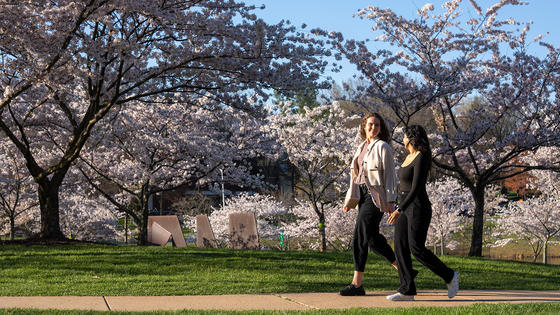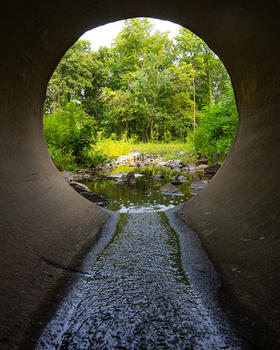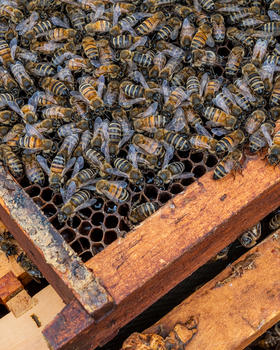In many ways, George Mason University is a small town with a population of about 48,000. That’s a little bit bigger than Charlottesville, Virginia, which clocks in at 45,000.
Of course, this population isn’t all in one place.

In Virginia, Mason has campuses in Fairfax County, Arlington County, and Prince William County, and sites in Loudoun County and on Belmont Bay in Woodbridge. There’s a contingent of students and researchers in Front Royal. On the other side of the globe, Mason Korea is about to celebrate its 10th year in Songdo, South Korea.
Our award-winning faculty is dedicated to tackling the grand challenges of our time, which include issues surrounding sustainability. That dedication can be seen anywhere you set foot on a Mason campus, with our nearly 1,000 acres of land, waterways, forests, and buildings being used as a dynamic Living Lab for hands-on applied environmental research.
From the canopies of the trees in our accredited Level II Arboretum to the stormwater running into Mason Pond, from our Green Leaf courses to serving as home to the commonwealth’s Virginia Climate Center, our experts are conducting research locally that can and will have an impact globally.
In 2011, Mason began reporting its sustainability progress to the Sustainability Tracking, Assessment, and Rating System (STARS) from the Association for the Advancement of Sustainability in Higher Education and earned a Silver rating. By 2014, we were the first university in Virginia to achieve a Gold STARS rating.
In 2012, Mason committed to supporting the United Nations Global Compact, the world’s largest corporate sustainability initiative. The UN’s 17 Sustainable Development Goals also drive much of the work coming out of the university’s Institute for a Sustainable Earth (ISE).
And still, Mason aspires to do more.
Putting Research into Practice
Part of what’s driving the Living Lab research, according to Andre Marshall, Mason’s vice president of research, innovation, and economic impact, is the desire to integrate Mason’s research and academic strengths in sustainability with campus operations to mitigate Mason’s impact on the environment and be good stewards of the resources we have.
He sees the value of the campuses serving as a test bed and “demonstration avenue” to test the effectiveness of these solutions so that “they can become realized beyond just the ideation stage.” In fact, as Virginia’s largest public research university, such experimentation is a responsibility.
For Leah Nichols, executive director of ISE, the Campus as a Living Lab concept “puts Mason research into practice here at home and helps launch solutions that can have global impact.”
As a Living Lab, Mason aims to stimulate and support the development of new research and scholarship that use the campuses and their physical and socio-ecological structures for experimentation and education to develop and advance sustainability solutions.
The success of a Living Lab is not just in the testing but also in the approach and collaboration. There are many campus partners involved in this work, from Mason Facilities, the 10 schools and colleges, and 600 faculty members, to the University Libraries and a university- wide Sustainability Council.
Frank Strike, vice president of Mason Facilities and Campus Operations, says the vision to see our campuses as a Living Lab sprouted years ago, when teams recognized Mason had the internal expertise to find solutions to the university’s challenges right here, and that could additionally have an impact on the student experience.
“This benefits students who get another opportunity for a hands-on approach to their learning experiences by approaching the work across disciplines, which is a priority for Mason, and by sharing teaching models across programs and operations,” says Strike.

Water, Water Everywhere
Mason Pond is a popular place to hang out and the backdrop of countless graduation photos, but not many people realize that it is a critical part of Mason’s stormwater management.
“The stormwater channels that look like streams are the actual stormwater system,” says Mason researcher Jennifer Sklarew, PhD Public Policy ’15, a professor in Mason’s Department of Environmental Science and Policy. “The pipes outflow into those streams, and then everything goes into the pond.”
Sklarew is currently working with students on a hydro-power project, supported by the Patriot Green Fund, that will attempt to use that stormwater as a source of cleaner electricity by installing microturbines with battery storage at two sites on the Fairfax Campus.
The university just completed a stream restoration project that not only improved the flow of the waterways but also added asphalt sidewalks and some lighting so the campus community can enjoy the paths.
Project manager Deniz Callahan of Facilities says Mason faculty members were involved in planning early on and provided some advice and expertise. This included a list of native plants that could improve the health of the riparian buffer without introducing invasive species. There are also plans for a “foragers’ forest” to be established along the path.
But that is just the beginning when it comes to how Mason handles water resources on our campuses by using research and technologies that can be applied to the broader community.
At Mason Square, Mason Innovation Partners encountered a serious infrastructure issue that posed a frequent stormwater challenge for the area surrounding the new Fuse building. The existing county culvert was undersized and couldn’t handle the amount of stormwater that regularly comes through Arlington.
Replacing the culvert required precise coordination with the future building’s foundation design and intricate sequencing to control the constant flow of stormwater as it was diverted from the old culvert pipes to a new 12’ by 6’ box culvert.
Facilities also has an extensive list of mitigation protocols it applies, including illicit discharge detection and elimination and runoff control for the construction site and storms.
Pondering the Pond
Earlier this year, Mason graduate student Jamie Roth worked with the Patriot Green Fund and Facilities to purchase and install a weather monitoring station and trail cameras by Mason Pond.
Working with students in two statistics classes, Roth and others have been gathering data about the Yoshino cherry trees and the environmental conditions by the pond. Mason statistics students have collected and analyzed data on the bloom date of the cherry trees as a part of their coursework in STAT 490 Capstone in Statistics and STAT 634 Case Studies in Data Analysis and have integrated it with Mason’s local meteorological data. As a result of their work, the variations can be tracked over time to build a more accurate model for the bloom date of the cherry trees at Mason.
This research builds on the international Cherry Blossom Prediction Competition, which Department of Statistics professors Jonathan Auerbach and David Kepplinger help organize annually. This competition assembles data on the peak bloom date of cherry trees all around the world from Kyoto, Japan, to Vancouver, British Columbia.
“We hope to use the long-term data on Mason’s cherry trees to raise awareness and bring the concept of climate change closer to home,” says Roth.

Buzzing with Activity
Since the Honey Bee Initiative was launched in 2013, the project has led to a large number of innovative teaching and research projects and public–private partnerships.
A multidisciplinary team of Mason researchers has been working on a project at the Science and Technology Campus to see if the honey produced by bees can help locate missing persons. Perennials featuring some of the honey bees’ favorite flowers have been planted at the Forensic Science Research and Training Laboratory in support of ongoing research to determine if chemical traces of human remains can be identified in the plants or in the honey produced by the pollinators.
Engineering students are also working to make the campus apiaries into smart hives. A team of electrical and computer engineering students, mentored by Mason engineering professor Nathalia Peixoto, used the smart hive implementation as their senior cap-stone project.
Over the course of an academic year, the team designed and installed an internet-of-things-enabled sensor array, which is powered by solar panels, to monitor carbon dioxide and temperature in real time to track and predict the health of hives located by Pres-dents Park on the Fairfax Campus.
Getting Smart About It
Green Assessment and Decision Guidance Tool (GADGET) is probably the least visible Living Lab project, but it’s among the most comprehensive and complex. College of Engineering and Computing professor Alex Brodsky and his team are working to develop a tool that will help Mason reduce our carbon footprint and achieve carbon neutrality by 2040 in the most cost-effective way.
Brodsky and his team are gathering data on things like heating and cooling efficiency, energy costs and storage, and contractual agreements to create an algorithm and a computer model that university leadership will be able to use to project costs and savings and make sound decisions regarding Mason’s space and energy needs.
Having smart buildings like Mason’s Horizon Hall is also affecting the way Mason teaches data science. With funding from the National Science Foundation and the U.S. Department of Energy, engineering associate professor David Lattanzi is working with a team to improve the educational experience for students by integrating data science into Mason’s engineering curriculum and providing hands-on experiences with Mason’s own smart buildings.
Supporting Researchers
Mason’s Living Labs have a dedicated webpage and other resources, thanks in part to the work done by Judit Ungvári, ISE’s research and innovation officer, and Sarah D’Alexander, MBA ’23, sustainability program manager for University Sustainability.
Ungvári and D’Alexander can help researchers obtain the necessary approvals and permissions to do their research on one of Mason’s campuses. Other resources available to the campus community to assist with research include funding, such as the Patriot Green Fund and ISE’s seed funding for Living Lab research projects, and infrastructure, like the Living Lab DataVerse, an accessible online archive of campus datasets provided by researchers that was created in partnership with University Libraries.
“Whenever I talk about sustainability work at Mason, I always emphasize that we really rely on collaborations, partnerships, and support from the entire Mason community in order to do this work,” says D’Alexander. “And I’m so excited to be able to say that Living Labs have had so much support.”
What’s Next
Coming online this fall is the Smart Grid Lab at Mason Square, which will enable students and researchers to conduct various hands-on experiments, work with hardware-in-the-loop (HIL) simulations, and analyze simulation data related to the campus’s power and energy systems.
“We can start observing the campus energy flow and collect data,” says Mason engineering professor Liling Huang, who directs the lab. “That can support our future research in data analytics, machine learning, digital twins, computing, or cybersecurity of the smart grid and smart cities.”
A student-led project to convert the Presidents Park Hydroponic Greenhouse to solar energy is also coming to fruition this fall with the installation of solar panels. Funded by the Patriot Green Fund and Facilities, the ground-mounted solar installation, a first at the Fairfax Campus, will provide a utility cost savings to power the greenhouse in the long term and decrease the university’s carbon footprint.
Shayla Brown, Sarah D’Alexander, and John Hollis contributed to this story.
This feature is from the Fall 2023 Mason Spirit magazine.
Related News
- November 3, 2023
- October 23, 2023
